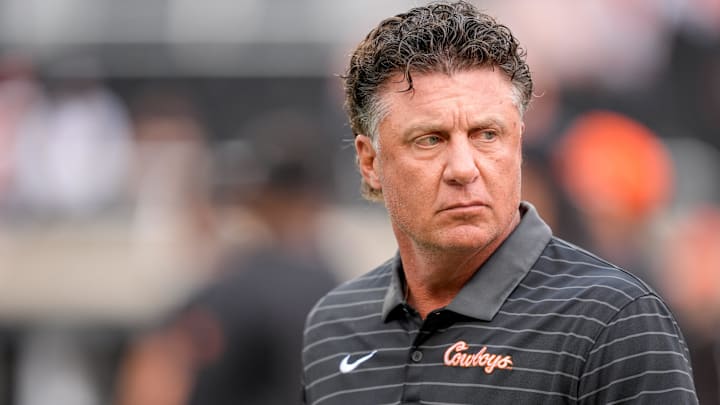As Oklahoma State evaluates its future beyond Mike Gundy, several strong candidates emerge. These individuals range from offensive gurus to proven leaders, with some even having direct ties to Stillwater. Below are five names worth watching as potential successors.
Zac Robinson, Atlanta Falcons Offensive Coordinator
Robinson’s connection to Oklahoma State runs deep. A former Cowboys quarterback from 2006 to 2009, he compiled impressive passing and rushing numbers under Gundy, making him a beloved figure among the fanbase. This matters more than many realize—having ties to a program and the opportunity to coach your alma mater carries significant weight when determining interest in a coaching job.
After several years gaining experience in the NFL, Robinson would bring an insider’s perspective on the program. He’s likely to implement a modern, pro-style offense that could attract top recruits and transfer targets with NFL aspirations. Coming from the Sean McVay coaching tree is another plus, as that lineage has produced numerous successful NFL head coaches and coordinators.
The main challenge for Robinson would be making the leap from coordinator to head coach—navigating recruiting, culture-building, and the full spectrum of running a college program. These are valid concerns, especially in today’s rapidly changing college football landscape. Still, the pros could outweigh the cons. If there’s mutual interest, Robinson could be a home run hire for Oklahoma State.
Alex Golesh, Head Coach at South Florida
Golesh brings valuable experience as a sitting head coach. At USF, he’s done an impressive job so far, showcasing both leadership and offensive creativity. Notably, he had an early stint as a graduate assistant at Oklahoma State, giving him familiarity with the region despite being an Ohio State alum.
His overall head coaching record at USF stands at 16-12, including a perfect 2-0 mark in bowl games—an important addition to his résumé. While some may expect instant success from hot coaching names, Golesh’s steady progress is encouraging. He’s won seven games in each of his two seasons, with bowl victories capping off both years.
Now in 2025, he’s led USF to massive early-season wins over Boise State and Florida, earning a Top 25 ranking. If Oklahoma State wants a coach with proven head coaching experience and a dynamic offensive mind, Golesh is a compelling option.
Jon Sumrall, Head Coach at Tulane
Sumrall has quietly built an impressive résumé. Known for his ability to motivate players, manage games, and maintain consistency, his time at Tulane has been marked by strong performances and upward momentum. Momentum matters—Sumrall won 23 games in just two years at Troy and has carried that winning culture into his new role at Tulane.
Last season, he won nine games and earned a bowl berth, and he’s off to a solid start again this year. At just 43 years old, he strikes a balance between youth and experience—an appealing combination for Oklahoma State. If the Cowboys want someone who can turn programs around and maintain competitiveness, Sumrall checks all the boxes.
Collin Klein, Offensive Coordinator at Texas A&M
Collin Klein is a familiar name in college football, particularly for Big 12 fans. A former Heisman finalist and Kansas State legend, Klein transitioned to coaching after a brief NFL stint. He worked his way up at Kansas State from graduate assistant to quarterbacks coach before taking the offensive coordinator role at Texas A&M.
Though Klein hasn’t held a head coaching job, his name is consistently mentioned as a rising star. For Oklahoma State, Klein would be a high-upside, calculated risk. He brings credibility, a Big 12 background, and offensive vision—qualities that might be exactly what the program needs at this transitional moment.
Andy Kotelnicki, Offensive Coordinator at Penn State
Kotelnicki has quietly become one of the more respected offensive minds in college football. His journey began in Division III before moving through Buffalo and Kansas, eventually landing at Penn State. With over a decade of experience as an offensive coordinator, his time to lead a program could be coming soon.
At Penn State, his work developing quarterback Drew Allar and modernizing the offense has drawn attention. That track record in quarterback development and offensive innovation could be a huge asset for Oklahoma State, particularly in attracting recruits and transfers. While he lacks head coaching experience, his fresh perspective and scheme creativity could give OSU the jolt it needs.
Conclusion
Oklahoma State stands at a crossroads. Do they pursue someone with deep ties to the program and a promise of continuity? Or do they gamble on a fresh face who brings innovation and new energy?
This conversation, of course, hinges on the possibility that Gundy doesn’t last the season or is dismissed after it ends. There are plenty of uncertainties for a historically proud program, but a new beginning might be exactly what both sides need. Choosing the right successor is critical—it could either accelerate the Cowboys’ return to national relevance or set them further back.
Whoever takes the job must restore energy, trust, and results—three things that will define whether Oklahoma State reemerges as a contender or slips further from the spotlight.
